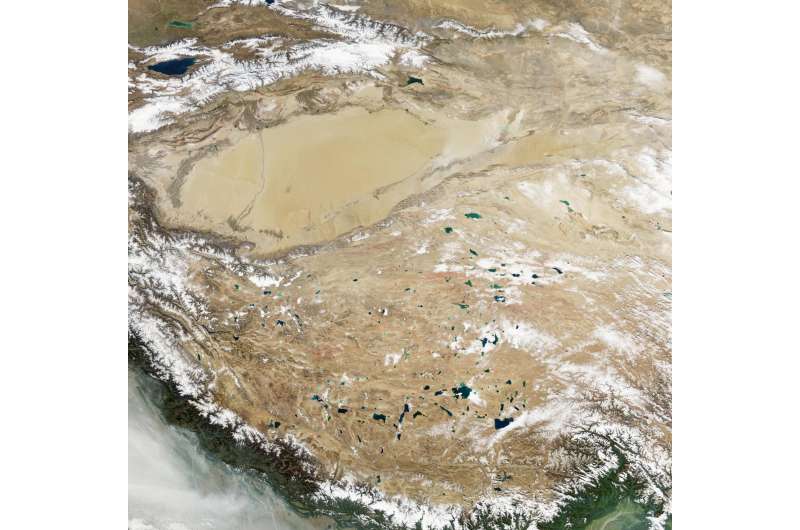Natural-colour satellite image of the Tibetan Plateau. Credit: NASA
As the highest region on Earth, the Tibetan Plateau engenders the most intriguing myths of Earth system science, provides the most water resources for human survival, and creates the most uncertain legacy for future generations.
The region's extreme environment kept researchers from probing its wealth of knowledge until the 1970s, when the Chinese Academy of Sciences (CAS) made the first scientific expedition to the region. In 1980, the first International Symposium on the Tibetan Plateau was held, marking the beginning of international collaboration on Tibetan Plateau research, which eventually developed into the Third Pole Environment (TPE), a sponsored flagship program under the auspices of UNESCO, UNEP, SCOPE, and CAS.
"The name 'Third Pole' was used to highlight the region's scientific significance as the third largest reservoir of frozen water after the Arctic and the Antarctic," said Yao Tandong, an elected member of CAS, who initiated the program with his counterparts Lonnie G. Thompson from the U.S. and Volker Mosbrugger from Germany in 2009. They were later joined by Deliang Chen from Sweden and PIAO Shilong from China.
This science-focused approach of TPE has paid off. According to a recent comment paper in Nature Reviews Earth & Environment, "TPE now includes over 300 researchers from 30 countries, with expertise spanning meteorology, hydrology, glaciology, ecology, and paleoclimatology."
Accomplishments and future goals of the Third Pole Environment Program. Credit: TPE
"We built TPE to enable scientists from different countries and across disciplines to compare notes," said TPE Co-chair Lonnie Thompson from the Byrd Polar and Climate Research Center, Ohio State University, where ice cores retrieved from the Tibetan Plateau are being studied in parallel with those from the Arctic and Antarctic as well as Peru. "Ice core records and tree ring records can also be compared to further calibrate our understanding of Earth's history," he added.
"Another strength of TPE is that it pools research resources worldwide to focus on the most demanding scientific tasks," said TPE Co-chair Deliang Chen, who is from the University of Gothenburg. "Key scientific questions just tend to surface when information is pieced together across countries and disciplines."
When putting recent observations in historical context, TPE scientists found that the most dramatic changes on the roof of the world over the past 2000 years all took place during the last 50 years, i.e., since the first scientific expedition to the Tibetan Plateau. These changes gave rise to the Second Tibetan Plateau Scientific Expedition and Research (STEP), a project launched in 2017 aiming to assess environmental changes since the first expedition along with their implications.
In his latest Nature Reviews Earth & Environment review article, Yao reported STEP findings that water storage in the region has been knocked off balance by climate change. It is now characterized by more liquid water and less solid water, with more liquid water in the north and less in the south.
"The rapid changes we found are alarming, making climate projection for the region more important than ever," said Deliang Chen, who leads a WCRP-CORDEX Flagship Pilot Study (FPS) project on the region's climate modeling. "For more accurate prediction, we are integrating our understanding of individual processes into a modeling framework covering various spatial scales."
"We are also taking a more active role in facilitating adaptation efforts," said Piao Shilong, deputy director of Institute of Tibetan Plateau Research of CAS who leads TPE efforts to assess the carbon budget of the region to informing climate-related policymaking.
More information: Tandong Yao et al, Reflections and future strategies for Third Pole Environment, Nature Reviews Earth & Environment (2022). DOI: 10.1038/s43017-022-00342-4
Tandong Yao et al, The imbalance of the Asian water tower, Nature Reviews Earth & Environment (2022). DOI: 10.1038/s43017-022-00299-4
Provided by Chinese Academy of Sciences
























